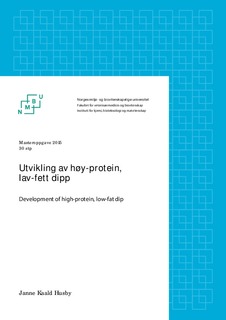Utvikling av høy-protein, lav-fett dipp
Master thesis

Åpne
Permanent lenke
http://hdl.handle.net/11250/2384049Utgivelsesdato
2016-04-05Metadata
Vis full innførselSamlinger
- Master's theses (KBM) [890]
Sammendrag
Fokuset på utvikling av meieriprodukter med et lavt fett- eller høyt proteininnhold er stadig økende. Det er også fokus på minst mulig bruk av tilsetningsstoffer i meieriprodukter. Tjukkmjølk er et tradisjonelt surmelksprodukt fra Røros-traktene i Norge, med en karakteristisk fyldig trådtrekkende konsistens. Denne spesielle konsistensen på melka kommer av den eksopolysakkarid (EPS) produserende melkesyrebakterien Lactococcus lactis subsp. cremoris som er å finne kulturen til Tjukkmjølk. Bruk av EPS i meieriprodukter kan være med på å redusere bruken av tilsetningsstoffer, da EPS kan fungere som en naturlig fortykningsagent siden den produseres in situ av melkesyrebakterier (MSB) som er ansett som trygge. I denne oppgaven ble det utviklet seks ulike syrnede melkeprodukter (kalt "dipp") med et lavt fett- (< 0,1 %) og høyt proteininnhold (10 %). Til fremstilling av disse produktene ble skummet melk proteinanriket med ulike fettfrie, melkeproteinpulvere (A, C, D) og podet med ulike kulturer. Den ene kulturen som ble brukt var produktet Tjukkmjølk og den andre en DL-kultur uten trådtrekkende egenskaper (CHN-11 kultur). Fokuset i denne oppgaven var å undersøke effekten av bruk av ulike proteinpulvere og kulturer, samt se om det var en forskjell mellom produkter som fersk og etter lagring i 3 uker, og mellom produkter som naturell og smaksatt med Holiday dipmix. Produktene ble sammenlignet med kommersielle produkter som Lettrømme og Mager Kesam, også som naturell og smaksatt med Holiday dipmix. For å undersøke dette ble foretatt både målinger av pH og mikrobiologiske-, kjemiske-, sensoriske- og reologiske analyser av ferske og lagrede produkter hhv. før poding, under- og etter syrning. På grunnlag av analysene ble det vist at det var mange signifikante forskjeller i pH utvikling, innhold (ppm) av ulike metabolitter, og sensoriske- og reologiske egenskaper mellom produkter laget med ulike proteinpulvere, kulturer, som fersk og lagret, og som naturell og smaksatt med Holiday dipmix. Det ble også vist signifikante forskjeller mellom proteinanrikede- og kommersielle produkter som både naturell og smaksatt med Holiday dipmix. De sensoriske vurderingene viste at de kommersielle produktene ble bedre likt enn de proteinanrikede produktene, og blant de sistnevnte kom produkter laget med pulvertype C og D, fermentert med Tjukkmjølk (CT, DT) ut som signifikant best. I tillegg ble produkter smaksatt med Holiday dipmix bedre likt enn de naturelle produktene. The focus on development of dairy products with low fat or high protein content is constantly
increasing. Attention is also focused on the least possible use of additives in dairy products.
Tjukkmjølk is a traditional fermented milk product from Røros tracts in Norway, with a
characteristic viscous and ropy consistency. This particular consistency of the milk comes from the
eksopolysakkarid (EPS) producing lactic acid bacteria Lactococcus lactis subsp. cremoris that
exists in the culture of Tjukkmjølk. Use of EPS in dairy products can contribute to reducing the use
of additives, since EPS can act as a natural thickening agent since it is produced in situ by lactic
acid bacteria (LAB), which is considered safe.
In this thesis, six different fermented milk products (called "dip") with a low fat (<0.01) and high
protein content (10 %) were developed. For the preparation of these products skim milk was
protein enriched with different fat-free, milk protein powders (A, C, D) and inoculated with various
cultures. One culture used was the product Tjukkmjølk and the other a DL-culture without ropy
properties (CHN-11 culture). The focus of this thesis was to investigate the effect of using different
protein powders and cultures, and sees if there was a difference between products as fresh and
stored for 3 weeks, and between products as natural and flavored with Holiday dipmix.
The products were compared with commercial products such as Lettrømme and Mager Kesam,
also as natural and flavored with Holiday dipmix. To study this, there were performed
measurements of pH and microbiology-, chemical-, sensory- and rheological analyzes of the fresh
and stored products respectively before inoculation, during- and after the acidification.
On the basis of the analysis, it was shown that there were many significant differences in pH
development, content (ppm) of various metabolites, and sensory- and rheological properties
between products made with different protein powders, cultures, as fresh and stored, and as natural
and flavored with Holiday dipmix. It was also shown significant differences between protein
enriched- and commercial products both natural and flavored with Holiday dipmix. The sensory
analyses showed that the commercial products was better liked than the protein enriched products,
and among the latter came products made with powder type C and D, fermented with Tjukkmjølk
(CT, DT) as significant best. In addition, products flavored with Holiday dipmix was better liked
than those natural products.
